Fleet Modernization Program (2340s)
More actions
The Fleet Modernization Program (FMP) of the 2340s and '50s was an initiative of the Advanced Starship Design Bureau, Starfleet Shipyard Operations, and the Starfleet Corps of Engineers to develop a number of new starship classes to bring the advancements pioneered by the Ambassador-class into widespread use across Starfleet. This program would culminate in the development of the Galaxy-class explorer, first launched in the late 2350s. This program did not see full completion, as the Battle of Wolf 359 prompted a rapid pivot towards designs that were combat hardened in the late 2360s.
The starships developed in this program are colloquially known as the Galaxy-class family, due to their obvious visual similarities. Indeed, it was intended that there would be a number of classes all based off of Galaxy-class technology that would make up the bulk of Starfleet as had happened with the cousins of the Constitution-class refit, but this never emerged thanks to the program's cancellation. Still, the result of this program are two of the most successful designs in Starfleet history (the Galaxy and Nebula-classes) as well as one of its most prolific: the California-class utility cruiser.
Background
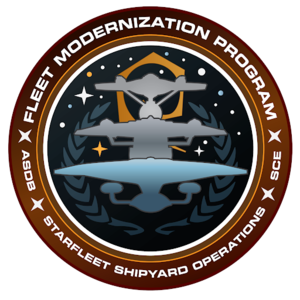
By 2340, the Ambassador-class heavy cruiser had entered service as the largest and most powerful Federation starship ever constructed, with innovations in nearly every system, but especially the warp drive and defensive systems. These units were few and far between, though, with the fleet still being made up largely of Excelsior, Miranda, Constellation, and Oberth-class starships, the latter three of which relied on technology developed in the 2270s, even as more modern systems were added in piecemeal. They were built because they were proven, reliable designs, but they were starting to lag behind the technological innovations being developed by the Corps of Engineers, and there were limits to how many new technologies could successfully be integrated into these designs, especially considering that the Miranda's original configuration dated back to the 2250s!
Within Starfleet Command, there was extreme reluctance to change course, given that the majority of the fleet's senior leaders had cut their teeth on these legacy classes, and so it took concerted lobbying on the part of the Advanced Starship Design Bureau to receive permission to try something new: most of the time, Starfleet had preferred to develop a flagship class (such as the Constitution or Excelsior) first to allow other classes to be derived from these large, expensive designs, but the ASDB proposed doing the opposite instead. This time around, smaller classes would be developed that would incrementally introduce the innovations that would culminate in the flagship design: the Galaxy-class, which had long been in the works as the eventual Ambassador-class successor.
This program would develop a science vessel, a scout, a light cruiser, and a frigate, each of which would be modern, highly-capable, and superior to the aging starships that fulfilled those roles in the 2330s and 2340s. This would be phases one and two, with phase three being the construction of the Galaxy-class and Nebula-class starships which would supplant the Ambassador and Excelsior, resulting in a full complement of new starship designs on the books by 2360. Starfleet Medical lobbied for a new dedicated medical ship, and so the Olympic-class was developed as part of phase three, though it didn't tLate in the process, it the California-class utility cruiser was added to phase three as well.
It was originally intended that phase four (to occur in the late 2360s) would further evaluate the phase one and phase two designs to develop further medium and small designs that would complement the phase three designs, but this part of the program was cancelled following the Battle of Wolf 359. In spirit, it lived on in the design program that resulted in the Intrepid-class light explorer and the Nova-class surveyor in the early 2370s, though it was not strictly speaking part of this initiative.
Phase One (2342-2345)
The first and most visible part of the FMP was to settle on a common hull geometry and construction process for this new wave of ships. Rather than a circular primary hull (as was present on every previous major Starfleet class to that point), it was decided instead to use an elliptical design. This design would allow for more compartments in the primary hull to have viewports, the lack of which was a common complaint among crew members. In addition, the interlocking structural framework that was designed to support this elliptical structure would be the strongest space frame ever developed. The two ships in this phase would test competing primary hull designs: the Cheyenne a shape first debuted aboard the Constitution-class with roughly symmetrical dorsal and ventral surfaces where the rim of the saucer was narrower than the center; and the Springfield a wholly-new design where the dorsal surface's taper was much more gradual, thus providing more space.
Engine systems would be enhanced versions of those used aboard the Ambassador-class: the class-five warp core and fully-independent fusion-driven impulse engines, the latter of which were considered especially important, as designs derived from the Constitution-class refit of the 2270s relied on a combination warp-impulse reaction assembly that had benefits when it came to fuel efficiency, but which led to an extremely complex internal reactor structure, as well as meaning that primary power failure meant the failure of both warp and impulse systems. To save on production expense, the warp coils in use aboard the two classes of Phase One were of a simplified design based on the general layout of Ambassador-class warp nacelles, but with a squared-off design and truncated Bussard collectors.
Springfield-class Science Vessel (2345)
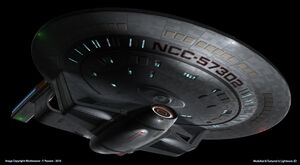
Main Article: Springfield-class science vessel
The Springfield-class starship was the first vessel to be produced as part of the FMP. It served as the testbed for one of two competing primary hull designs (the other being tested on the Cheyenne-class) and of a modular pod system that served as the basis of the pod used later on the Nebula-class. This class proved to be very successful, as it had a much higher standard of accommodation than either the Oberth-class surveyor or Miranda-class ships fitted for scientific duties, while also being a substantially lower resource investment than a heavy cruiser. The primary hull design pioneered on the Springfield was selected as the basic design for the ships in Phase Two.
Cheyenne-class Light Cruiser (2345)
Main Article: Cheyenne-class light cruiser
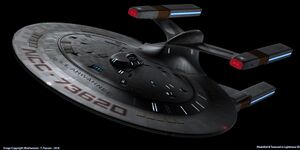
The Cheyenne-class light cruiser was developed as a successor to the Constellation-class cruiser, using the same four-nacelle design to increase endurance. This class was the first purpose-built class that could separate its primary and secondary hulls and reconnect them without starbase support or extended downtime, as well as an alternate primary hull arrangement. This design proved to be less successful than the Springfield-class, though the saucer separation proof of concept would go on to pave the way for this functionality in many other classes in future decades.
Phase Two (2345-2352)
With the Springfield and Cheyenne-class vessels in production and undergoing rigorous shakedown operations, Phase Two commenced with the Challenger-class and New Orleans-class designs, building off of what was learned in Phase One. As these two newer classes were designed, production on the Phase One vessels was ramped up, with many Miranda and Constellation-class vessels being replaced by their successors. The priority for Phase Two was to lock down the warp coil design that would be incorporated aboard the Galaxy and Nebula-class vessels, as well as their tactical systems.
Still essentially based off of Ambassador-class technology, the semi-toroidal warp coils developed in this phase were innovative in that each nacelle technically had two sets of coils, an upper and a lower set, which offered increases in efficiency and the ability to fine-tune warp fields to a degree that had never before been possible. They took the form of the characteristic rounded, elliptical cross-section nacelles that were the hallmark of ships designed in the 2350s. In addition, the characteristic navigational deflector design was also introduced in this phase.
Challenger-class Scout / Courier (2350)
Main Article: Challenger-class scout
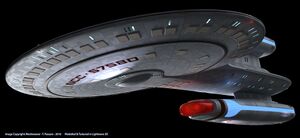
The Challenger-class was first launched in 2350 and employed a unique vertical stack arrangement of its warp nacelles, which were of the same semi-toroidal warp coil design that would eventually be used aboard the Galaxy and Nebula. The advantages of this warp engine design were evident immediately in the ship's high top speed and maneuverability (thanks to thruster points being built into the structure of the nacelle itself). Another design feature tested aboard this class was yet another primary hull variation, in this case a symmetrical design with both the dorsal and ventral surfaces of the primary hull having a very gradual taper to maximize internal volume, to help nail down the final shape of the Galaxy and Nebula-class saucer. In the end, it was decided that the design developed for the Springfield would go on to serve as the basis of the larger ships. The Challenger-class itself enjoyed a moderate production run, but fewer of them were built than either the Springfield or New Orleans-classes, due to these other two classes overlapping enough of their niche not to need many dedicated scouts or couriers.
New Orleans-class Frigate (2352)
Main Article: New Orleans-class frigate
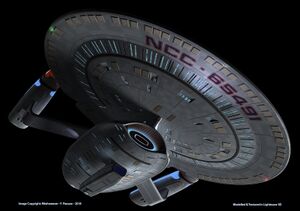
The New Orleans-class was the testbed for the tactical systems that would be employed by the largest members of the FMP, namely the Type-X phaser array and burst-fire torpedo launcher. It also debuted the trademark elliptical-shaped deflector dish in use aboard the Phase Three classes, along with the overall hull geometry that would be used aboard the Galaxy-class. This ship was the most effective and well-rounded of all of the phase one and two ships, and saw the largest production run. In fact, as Phase Two wrapped up, it was envisioned that the New Orleans-class might eventually make up the bulk of Starfleet's medium-sized ships, as there was a clear performance difference between this class and the Miranda and Constellation-class starships then serving in similar roles, but there was also a substantial resource cost difference.
Phase Three (2352-2368)
Phase three saw the culmination of this program with the development of the Galaxy-class explorer and Nebula-class heavy cruiser, both of which would become iconic and long-serving starship classes. Production on the phase one and two starships continued apace, with improvements made for later classes gradually being integrated into the designs. By the early 2360s, all four of these classes mounted Type-X phaser arrays as well as burst-fire torpedo tubes, but it was decided not to upgrade either the Springfield or Cheyenne to the new warp engine design, as doing so would require too much reworking of their designs. Still, there was a large degree of commonality amongst this family of ships, which aided both production efficiency and crew training. Individually, the phase one and phase two classes each performed better than legacy classes in their design roles, causing many Miranda and Constellation-class ships to be retired. The Springfield was significantly larger than the Oberth, though, and so never fully displaced it as a surveyor.
The Galaxy-class and Nebula-class designs were both finalized in 2350, with construction starting even as the New Orleans-class commenced its trials on their tactical systems. These two classes were significantly larger and more complex than any other starships built to that point and took six years to complete, with their prototypes not launching until 2356. A large factor in their long design and shakedown program was the new Class-6 warp drive that was in use aboard both classes. These two classes were both undergoing shakedown operations until 2359. All six Galaxy-class starships were completed by 2365, with the Nebula-class replacing the few remaining Ambassador-class orders in that same year. A dedicated medical and transport ship, the Olympic-class was added to this phase in 2355 and entered service slightly after the Galaxy.
In the same year, it was felt that while the four smaller classes of this family carried out their specialist duties well, a modern generalist starship was needed to handle engineering, scientific, and humanitarian projects of low or medium priority within the Federation itself, and so the California-class design was added to this program. It was meant to be a design that was widely reconfigurable, in a way that the Cheyenne--the most generalized of the bunch--was not.
Nebula-class Heavy Cruiser
Main Article: Nebula-class heavy cruiser
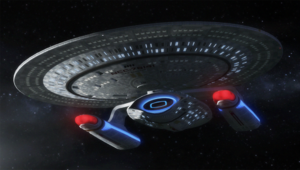
Designed to operate in much the same role as the Miranda-class initially did with the Constitution-class, the Nebula-class is a well-rounded heavy cruiser design that uses all of the innovations developed for the phase one and two starships: Type-X phaser arrays, burst-fire torpedo tubes, and a large mission module. It was intended to supplant both the Excelsior-class and the Ambassador-class as a multi-role exploration starship. Though this design is far less famous and iconic than the Galaxy-class that she entered service alongside, the Nebula-class has had a longer and larger production run, entering the fleet at a volume similar to the Excelsior-class.
There are two distinct variants of this class: the original with a hull design that had more cargo space and fewer crew quarters compared to the Galaxy-class, and the current design introduced in 2366 which uses components nearly-identical to those aboard the Galaxy-class.
Galaxy-class Explorer
Main Article: Galaxy-class explorer
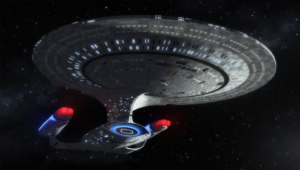
The Galaxy-class was the first starship to be officially designated an "explorer," filling a role beyond that of a simple heavy cruiser. This starship was meant to be able to undertake indefinite missions of exploration far beyond Federation space, while also carrying the heaviest ship-mounted weapons ever developed by the Federation, which would allow it to serve an important role in Starfleet's defense program. The production process for this class was very long, with the prototype enduring nearly six years of shakedown operations, before the Enterprise and Yamato were launched in 2363. This was not altogether surprising, though, as the Galaxy-class was one the largest and most advanced vehicle built at the time. Indeed, she would not be surpassed in volume until the introduction of the Odyssey-class decades later.
Olympic-class Cruiser
Main Article: Olympic-class cruiser
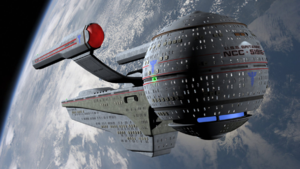
The Olympic-class cruiser was added to the Fleet Modernization Program late in the process. Unlike other ships in this series, it doesn't pioneer anything specifically, but rather relies on advances made in other classes of the era: computers, nacelles and hull materials derived from the Springfield, holodecks from the Galaxy, and warp core enhancements from the New Orleans-class. After a short design process, the Olympic entered service in 2365. Essentially a passenger liner, which was dominantly configured for medical roles, but which also could be used for scientific purposes, it proved to be immediately successful and it remains in production.
California-class Utility Cruiser
Main Article: California-class utility cruiser
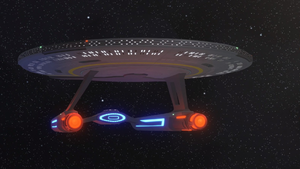
A late addition to the program, the California-class was developed with the innovations made for the other classes in the fleet modernization program, but with a focus on reliability and the ability to conduct a wide variety of low to medium-intensity missions within Federation space. Dubbed a utility cruiser, she was meant to perform the same role as Miranda and Oberth-class starships relegated to second-line duty, which largely involved moving goods or people from place to place, whether they be engineering teams, medical supplies, or important dignitaries. The class was immediately and quietly successful and remains in production.
Cancellation and Legacy
2367 would spell the end of this iteration of the Fleet Modernization Program, though, as the devastating Borg attack that culminated in the Battle of Wolf 359 not only destroyed many of the new units of these classes, but also caused a full-180 in terms of Starfleet's shipbuilding priorities. All four phase one and phase two classes were cancelled in favor of more battle-hardened designs, with the last units developed in those phases of the program leaving the yard in 2369. The phase three designs were hardened, but continued in production as planned.
In later evaluations of the philosophy from this program, the Starfleet Corps of Engineers came to the conclusion that the smaller designs in phases one and two were too specialized and too experimental, and the fleet may have been served better if they had been built in even smaller numbers, with more capable classes being developed after the Galaxy and Nebula, but this happened in practice through the program that introduced the Saber, Steamrunner, Norway, and Akira-class starships.
Furthermore, the downsides of putting all of one's eggs in one basket (evidenced by the destruction of the Galaxy-class starships Yamato, Enterprise, and Odyssey all within five years of one another) led to the development of the Intrepid-class light explorer and the Nova-class surveyor, and in turn to the Sovereign-class explorer, which was much more attuned to combat than the Galaxy. While not part of the FMP, these vessels could be considered part of what would have been phase four.

